1997 CHEVROLET CAVALIER wiper blades
[x] Cancel search: wiper bladesPage 94 of 388
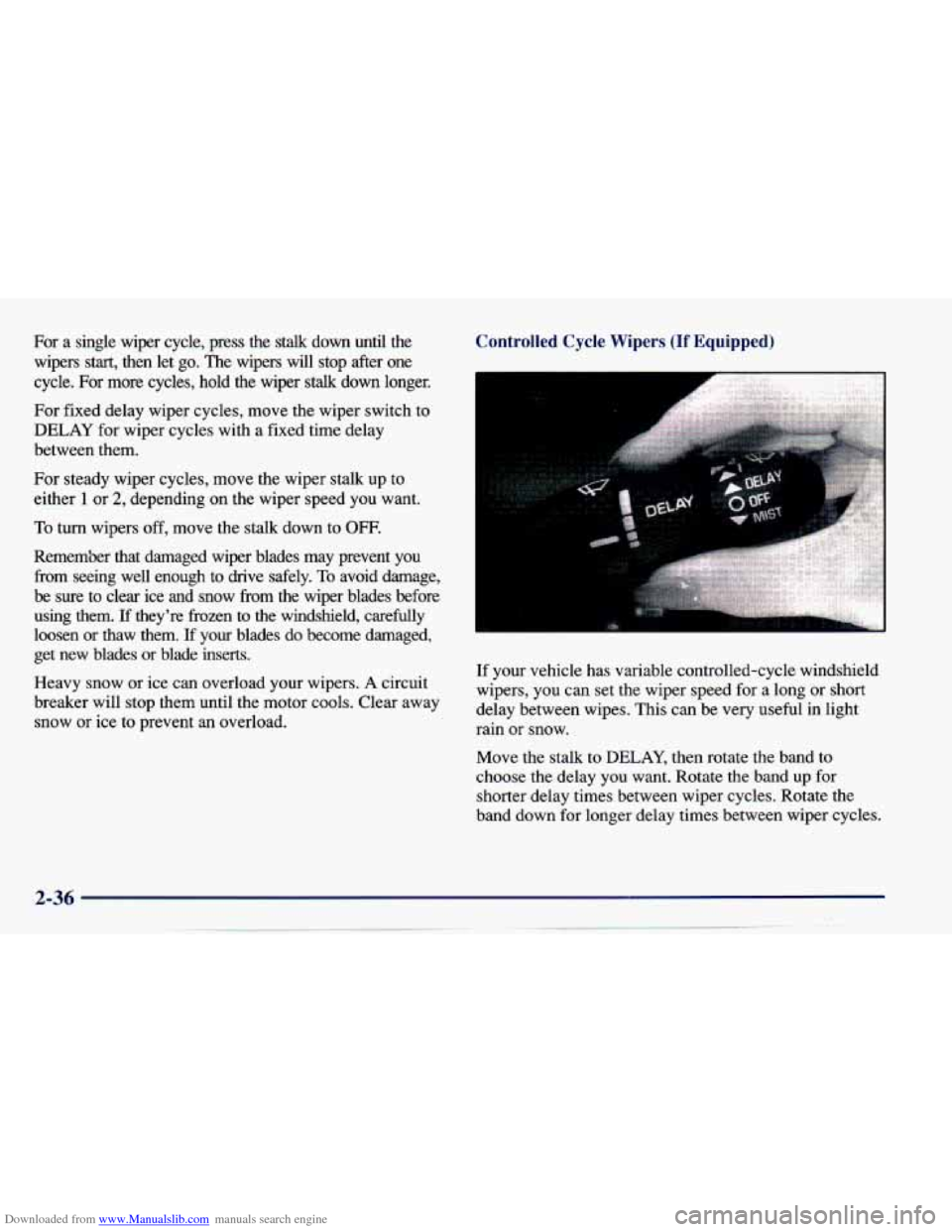
Downloaded from www.Manualslib.com manuals search engine For a single wiper cycle, press the stalk down until the
wipers
start, then let go. The wipers will stop after one
cycle. For more cycles, hold the wiper
stalk down longer.
For fixed delay wiper cycles, move the wiper switch to
DELAY for wiper cycles with a fixed time delay
between them.
For steady wiper cycles, move the wiper stalk up to
either
1 or 2, depending on the wiper speed you want.
To turn wipers off, move the stalk down to OFF.
Remember that damaged wiper blades may prevent you
from seeing well enough to drive safely.
To avoid damage,
be sure to clear ice and snow from the wiper blades before
using them. If they're frozen to the windshield, carefully
loosen or thaw them.
If your blades do become damaged,
get new blades or blade inserts.
Heavy snow or ice can overload your wipers.
A circuit
breaker will stop them until the motor cools. Clear away
snow or ice to prevent an overload.
Controlled Cycle Wipers (If Equipped)
If your vehicle has variable controlled-cycle windshield
wipers, you can set the wiper speed for a long or short
delay between wipes. This can be very useful in light
rain
or snow.
Move the stalk to
DELAY, then rotate the band to
choose the delay you want. Rotate the band up
for
shorter delay times between wiper cycles. Rotate the
band down for longer delay times between wiper cycles.
2-36
Page 180 of 388
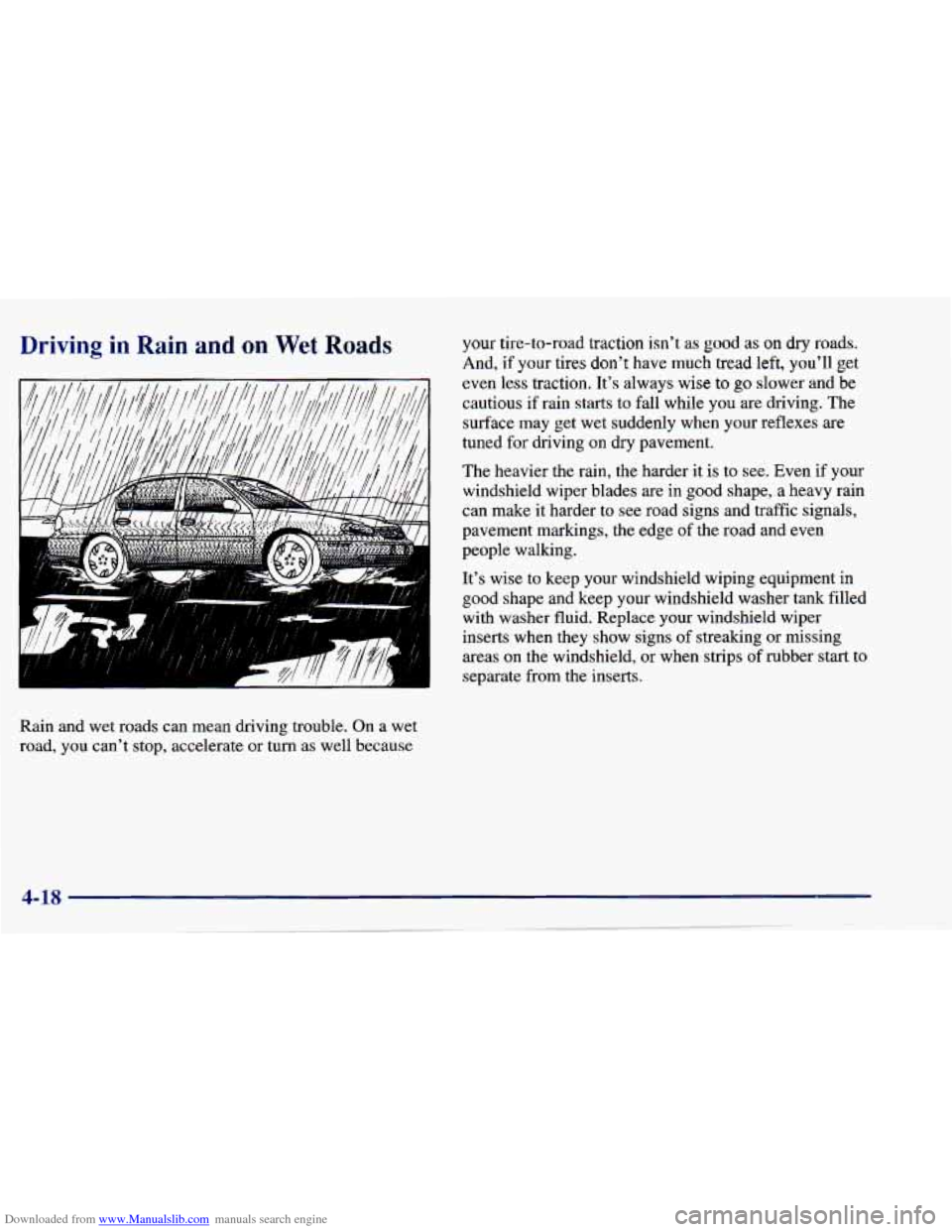
Downloaded from www.Manualslib.com manuals search engine Driving in Rain and on Wet Roads
Rain and wet roads can mean driving trouble. On a wet
road, you can't stop, accelerate
or turn as well because
your tire-to-road traction isn't as good as on dry roads.
And,
if your tires don't have much tread left, you'I1 get
even less traction. It's always wise to go slower and be
cautious if rain starts to fall while you are driving. The
surface may get wet suddenly when your reflexes
are
tuned for driving on dry pavement.
The heavier the rain, the harder it is to see. Even
if your
windshield wiper blades are in good shape, a heavy rain
can make it harder to see road signs and traffic signals,
pavement markings, the edge of the road and even
people walking.
It's wise to keep your windshield wiping equipment in
good shape and keep your windshield washer tank filled with washer fluid. Replace your windshield wiper
inserts when they show signs of streaking or missing
areas on the windshield, or when strips of rubber start to
separate from the inserts.
Page 185 of 388
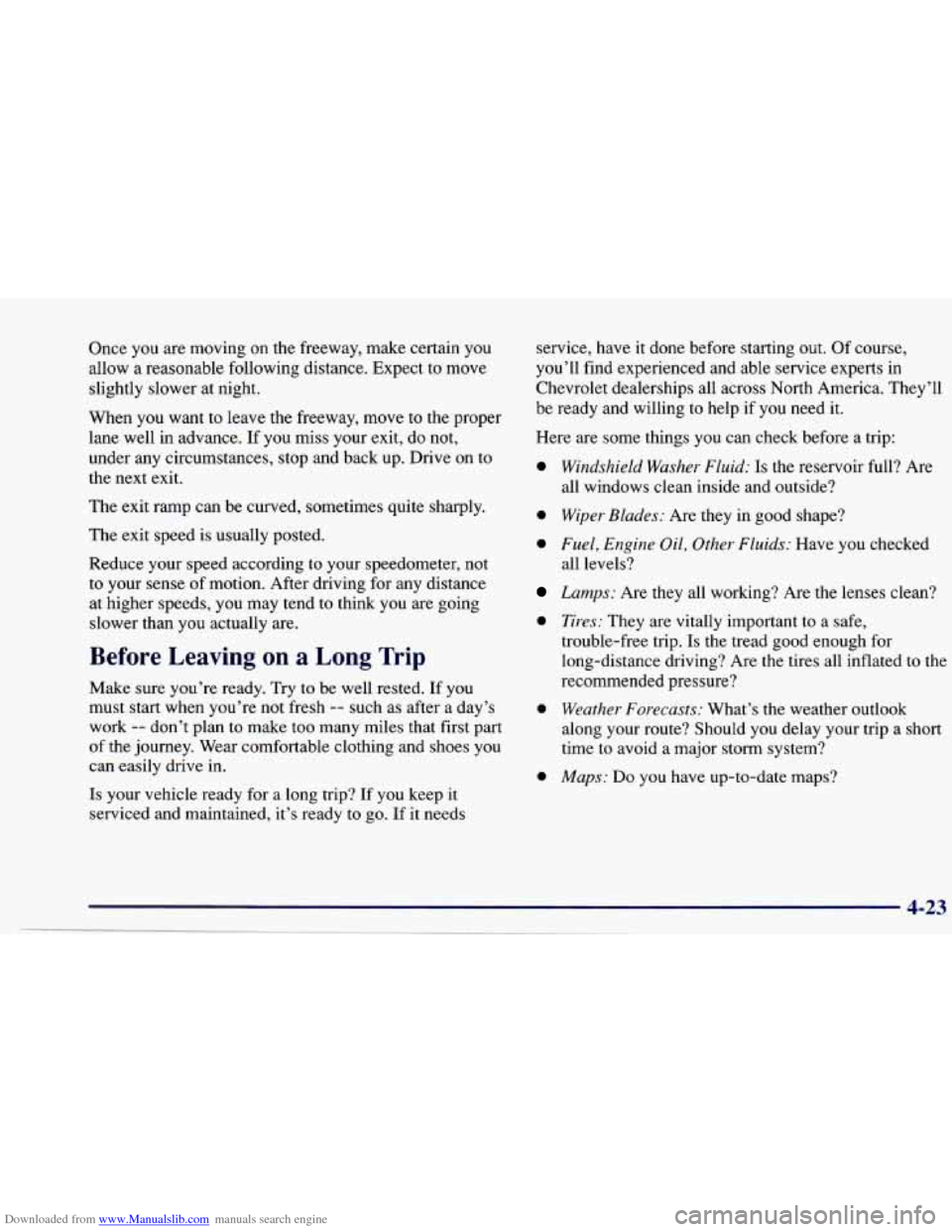
Downloaded from www.Manualslib.com manuals search engine Once you are moving on the freeway, make certain you
allow a reasonable following distance. Expect to move
slightly slower at night.
When you want to leave the freeway, move to the proper
lane well in advance. If you miss your exit, do not,
under any circumstances, stop and back up. Drive on to
the next exit.
The exit ramp can be curved, sometimes quite sharply.
The exit speed is usually posted.
Reduce your speed according to your speedometer, not
to your sense
of motion. After driving for any distance
at higher speeds, you may tend to think you are going
slower than you actually are.
Before Leaving on a Long Trip
Make sure you’re ready. Try to be well rested. If you
must start when you’re
not fresh -- such as after a day’s
work
-- don’t plan to make too many miles that first part
of the journey. Wear comfortable clothing and shoes you
can easily drive in.
Is your vehicle ready for a long trip? If you keep it
serviced and maintained, it’s ready to
go. If it needs service,
have it done before starting out. Of course,
you’ll find experienced and able service experts in
Chevrolet dealerships all across North America. They’ll
be ready and willing to help if you need it.
Here are some things you can check before a trip:
0
0
0
0
0
0
Windshield Washer Fluid: Is the reservoir full? Are
all windows clean inside and outside?
Wiper Blades: Are they in good shape?
Fuel, Engine Oil, Other Fluids: Have you checked
all levels?
Lamps: Are they all working? Are the lenses clean?
Tires: They are vitally important to a safe,
trouble-free trip.
Is the tread good enough for
long-distance driving? Are the tires all inflated to the
recommended pressure?
Weather- Forecasts: What’s the weather outlook
along your route? Should you delay your trip a short
time to avoid a major storm system?
Maps: Do you have up-to-date maps?
Page 282 of 388
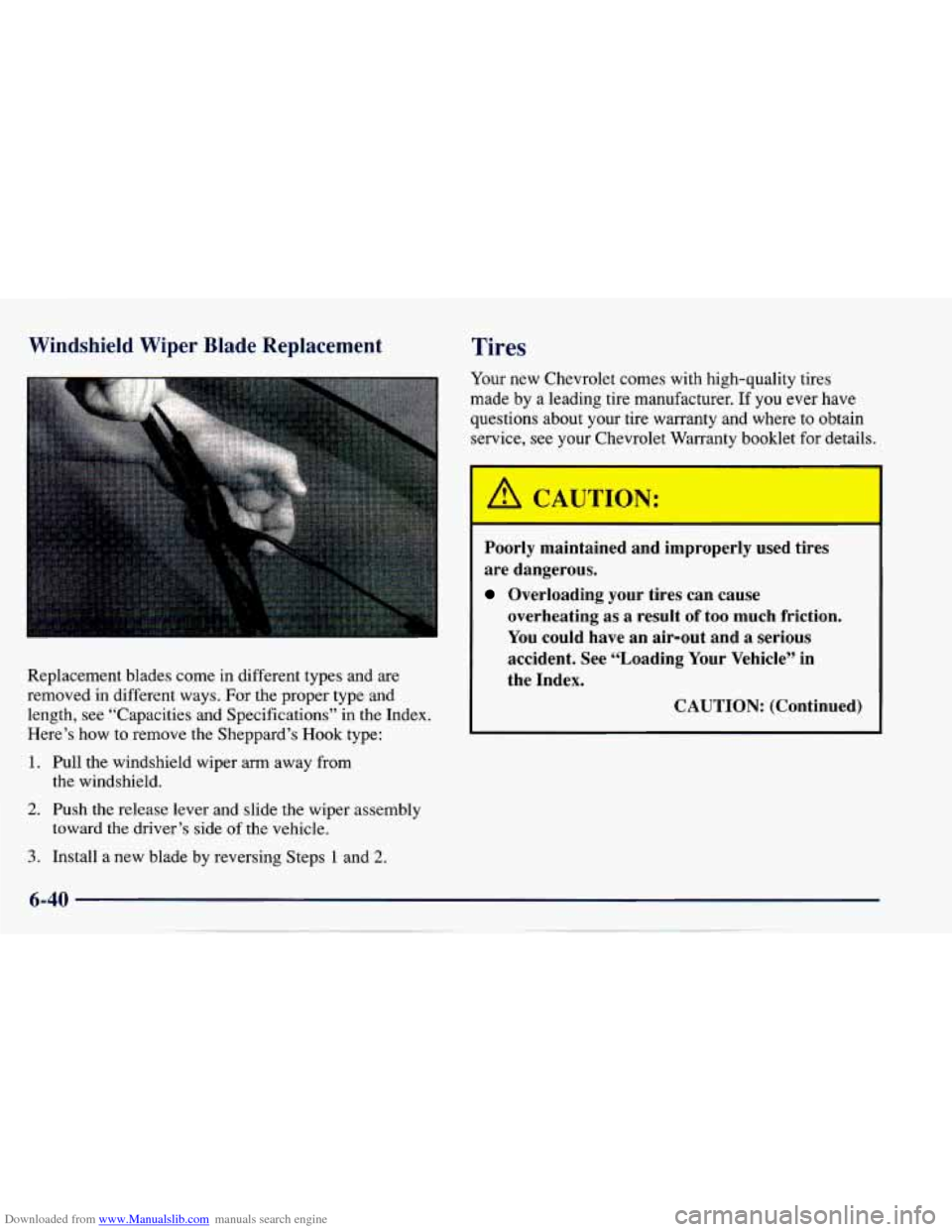
Downloaded from www.Manualslib.com manuals search engine Windshield Wiper Blade Replacement
Replacement blades come in different types and are
removed in different ways. For the proper type and
length, see “Capacities and Specifications” in the Index.
Here’s how to remove the Sheppard’s Hook type:
1. Pull the windshield wiper arm away from
the windshield.
2. Push the release lever and slide the wiper assembly
3. Install a new blade by reversing Steps 1 and 2.
toward the driver’s side of the vehicle.
Tires
Your new Chevrolet comes with high-quality tires
made by
a leading tire manufacturer. If you ever have
questions about your tire warranty and where to obtain
service, see your Chevrolet Warranty booklet for details.
I A CAUTION:
Poorly maintained and improperly used tires
are dangerous.
Overloading your tires can cause
overheating as
a result of too much friction.
You could have an air-out and a serious
accident. See “Loading
Your Vehicle” in
the Index.
CAUTION: (Continued)
Page 294 of 388
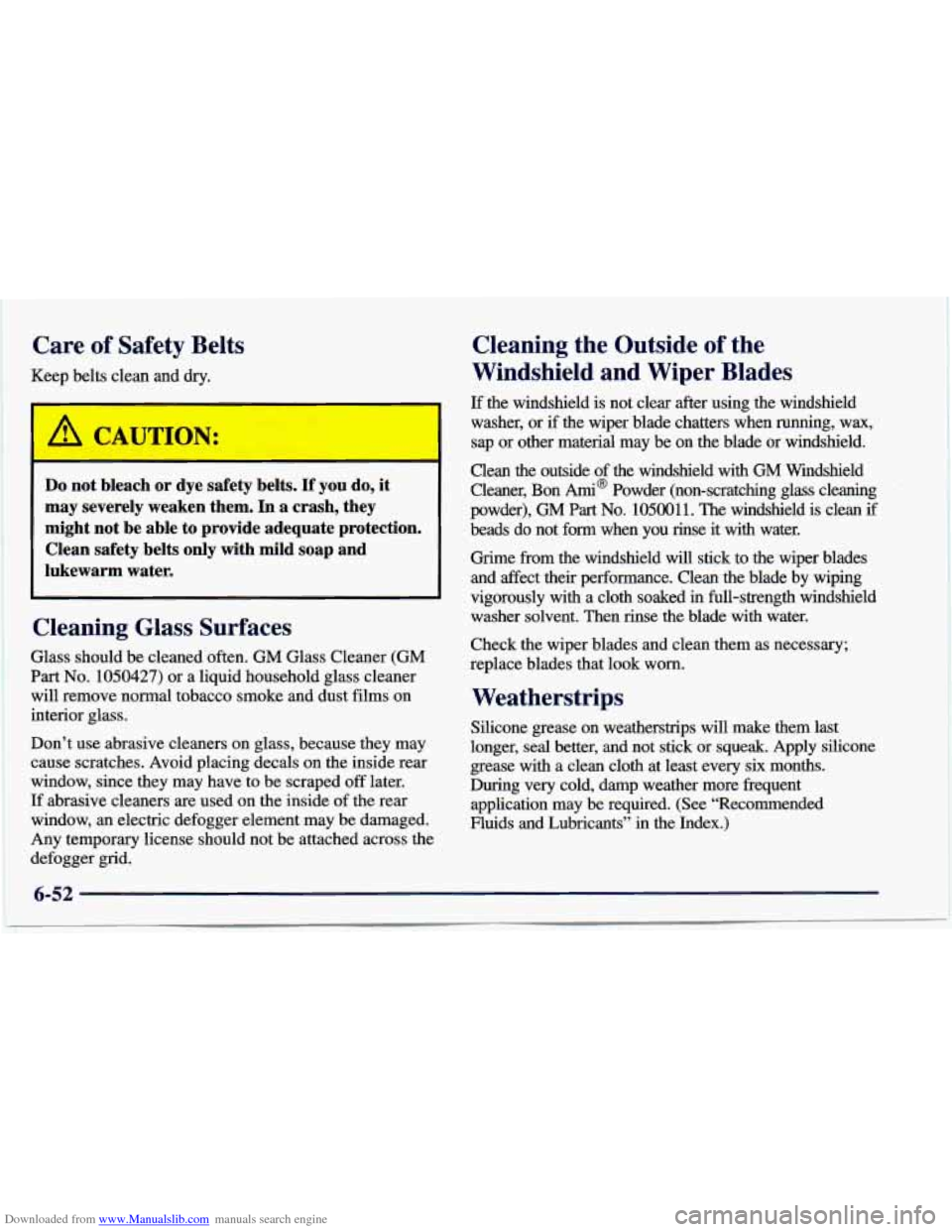
Downloaded from www.Manualslib.com manuals search engine Care of Safety Belts
Keep belts clean and dry.
I
Do not bleach or dye safety belts. If’ you do, it
may severely weaken them. In a crash, they
might not be able to provide adequate protection. Clean safety belts
only with mild soap and
lukewarm water.
Cleaning Glass Surfaces
Glass should be cleaned often. GM Glass Cleaner (GM
Part No. 1050427) or a liquid household glass cleaner
will remove normal tobacco smoke and dust films on
interior glass.
Don’t
use abrasive cleaners on glass, because they may
cause scratches. Avoid placing decals on the inside rear
window, since they may have to be scraped
off later.
If abrasive cleaners are used on the inside of the rear
window, an electric defogger element may be damaged.
Any temporary license should not be attached across the
defogger grid.
Cleaning the Outside of the
Windshield and Wiper Blades
If the windshield is not clear after using the windshield
washer, or if the wiper blade chatters when running, wax, sap or other material may be on the blade or ‘windshield.
Clean the outside of the windshield with GM Windshield Cleaner, Bon
Ami@ Powder (non-scratching glass cleaning
powder), GM
Part No. 1050011. The windshield is clean if
beads do not form when you rinse it with water.
Grime from the windshield will stick to the wiper blades
and affect their performance. Clean the blade by wiping
vigorously with a cloth soaked in full-strength windshield
washer solvent. Then rinse the blade with water.
Check the wiper blades and clean them as necessary;
replace blades that look worn.
Weatherstrips
Silicone grease on weatherstrips will make them last
longer, seal better, and not stick or squeak. Apply silicone
grease with a clean cloth at least every
six months.
During very cold, damp weather more frequent application may be required. (See “Recommended
Fluids and Lubricants” in the Index.)
6-52
Page 350 of 388
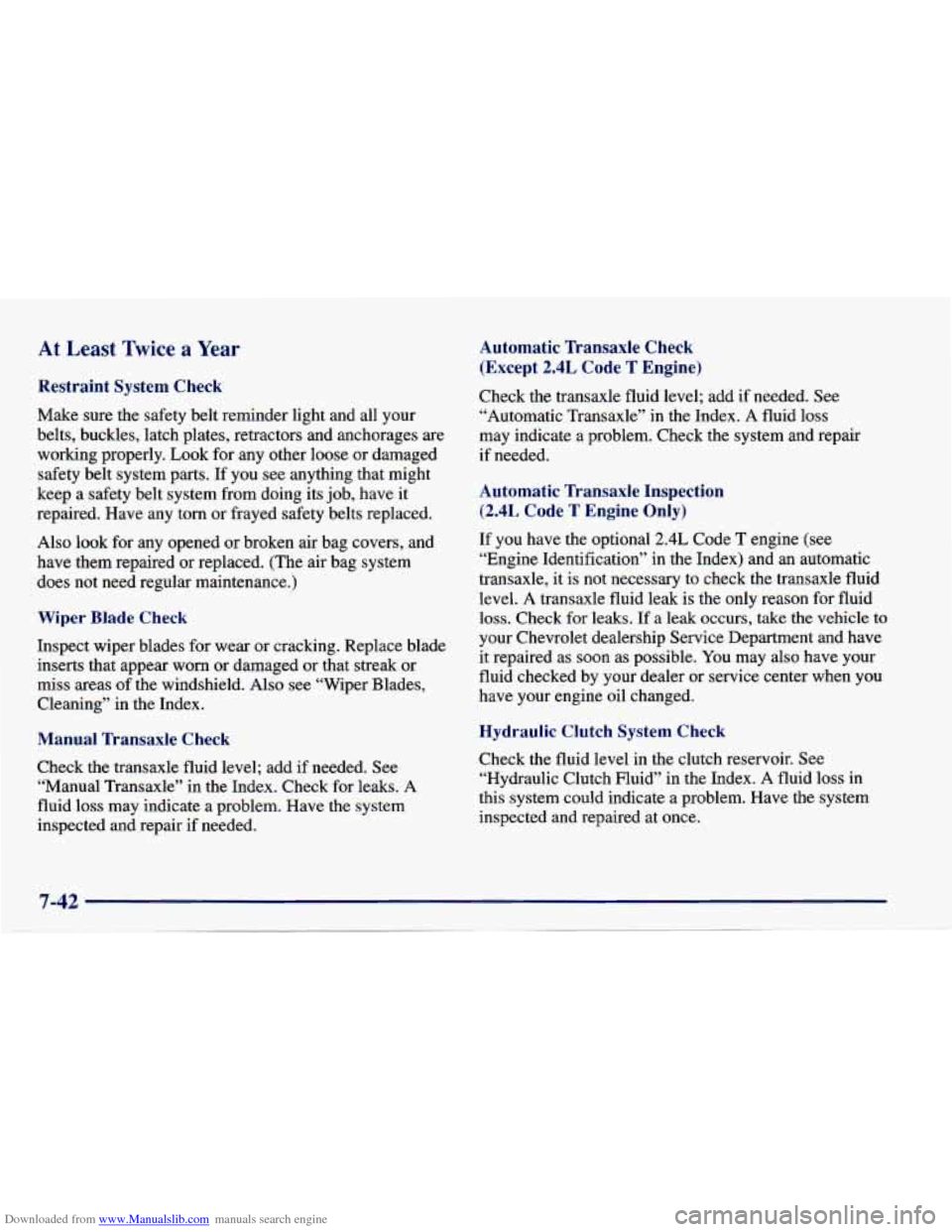
Downloaded from www.Manualslib.com manuals search engine At Least Twice a Year
Restraint System Check
Make sure the safety belt reminder light and all your
belts, buckles, latch plates, retractors and anchorages are
working properly. Look for any other loose or damaged
safety belt system parts.
If you see anything that might
keep a safety belt system from doing its
job, have it
repaired. Have any
torn or frayed safety belts replaced.
Also look for any opened or broken air bag covers, and
have them repaired
or replaced. (The air bag system
does not need regular maintenance.)
Wiper Blade Check
Inspect wiper blades for wear or cracking. Replace blade
inserts that appear
worn or damaged or that streak or
miss areas
of the windshield. Also see “Wiper Blades,
Cleaning” in the Index.
Manual Transaxle Check
Check the transaxle fluid level; add if needed. See
“Manual Transaxle” in the Index. Check for leaks. A
fluid loss may indicate a problem. Have the system
inspected and repair if needed.
Automatic Transaxle Check
(Except
2.4L Code T Engine)
Check the transaxle fluid level; add if needed. See
“Automatic Transaxle” in the Index. A fluid loss
may indicate a problem. Check the system and repair
if needed.
Automatic Transaxle Inspection
(2.4L Code T Engine Only)
If you have the optional 2.4L Code T engine (see
“Engine Identification” in the Index) and an automatic
transaxle,
it is not necessary to check the transaxle fluid
level.
A transaxle fluid leak is the only reason for fluid
loss. Check for leaks. If a leak occurs, take the vehicle to
your Chevrolet dealership Service Department and have
it repaired as soon as possible. You may also have your
fluid checked by your dealer
or service center when you
have your engine oil changed.
Hydraulic Clutch System Check
Check the fluid level in the clutch reservoir. See
“Hydraulic Clutch Fluid” in the Index.
A fluid loss in
this system could indicate a problem. Have the system
inspected and repaired at once.
Page 377 of 388
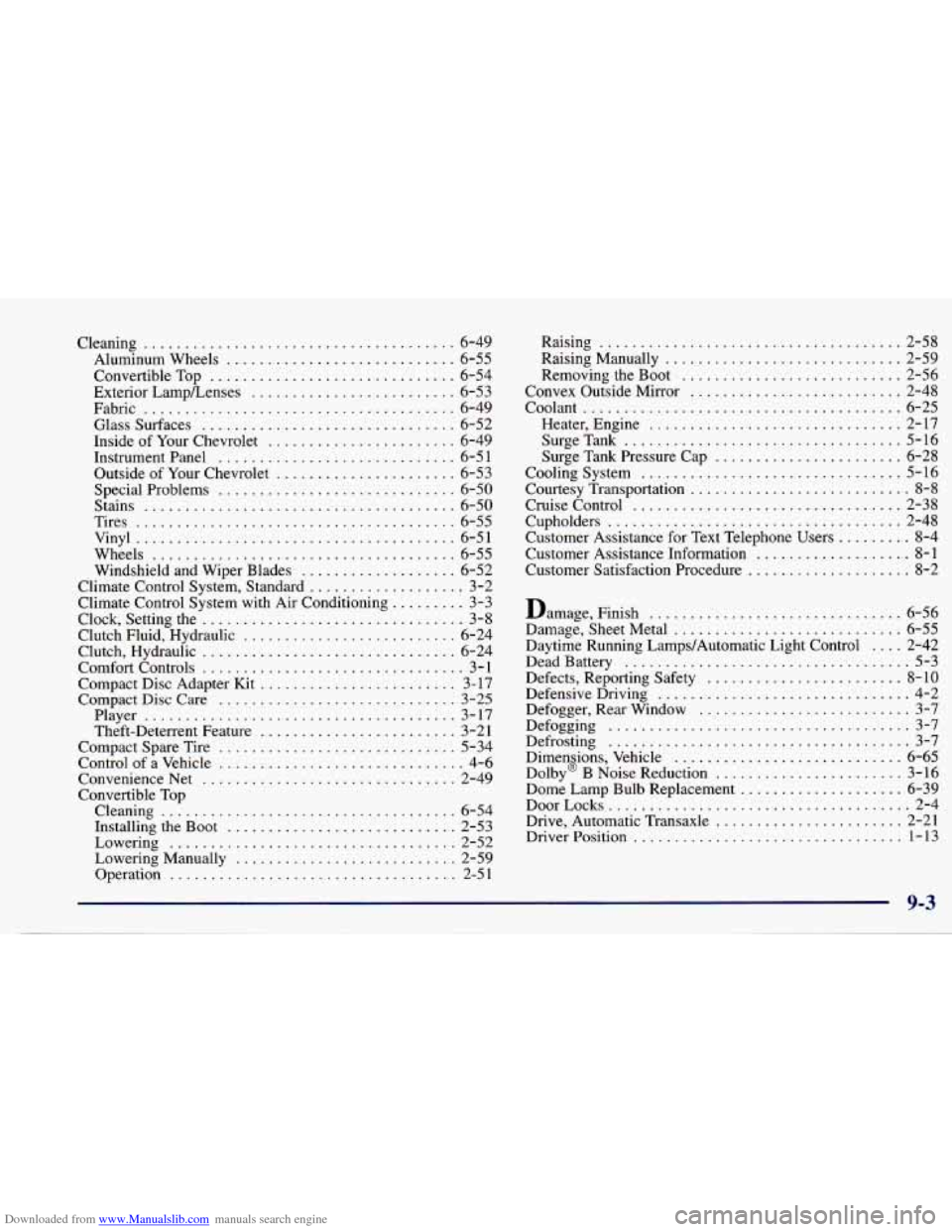
Downloaded from www.Manualslib.com manuals search engine Cleaning ...................................... 6-49
AluminumWheels
............................ 6-55
Convertible Top
.............................. 6-54
Exterior LampLenses
......................... 6-53
Fabric
...................................... 6-49
Glass Surfaces
............................... 6-52
Inside of Your Chevrolet
....................... 6-49
Instrument Panel
............................. 6-51
Outside
of Your Chevrolet ...................... 6-53
Special Problems
............................. 6-50
Stains
...................................... 6-50
Tires
....................................... 6-55
Vinyl
....................................... 6-51
Wheels
..................................... 6-55
Windshield and Wiper Blades ................... 6-52
Climate Control System, Standard
................... 3-2
Climate Control System with Air Conditioning
......... 3-3
Clock, Setting the
................................ 3-8
Clutch Fluid, Hydraulic
.......................... 6-24
Clutch, Hydraulic
............................... 6-24
Comfort Controls
................................ 3 - 1
Compact Disc Adapter Kit ........................ 3-17
Compact Disc Care ............................. 3-25
Player
...................................... 3-17
Theft-Deterrent Feature
........................ 3-21
Compact Spare Tire
............................. 5-34
Control of a Vehicle
.............................. 4-6
Convenience Net
............................... 2-49
Convertible Top
Cleaning
.................................... 6-54
Installing
the Boot ............................ 2-53
Lowering
................................... 2-52
Lowering Manually
........................... 2-59
Operation
................................... 2-5 1
Raising ..................................... 2-58
Raising Manually
............................. 2-59
Removing the Boot
........................... 2-56
Convex Outside Mirror
.......................... 2-48
Coolant
....................................... 6-25
Heater. Engine
............................... 2-17
Surge Tank Pressure Cap ....................... 6-28
Cooling System
................................ 5-16
Courtesy Transportation ........................... 8-8
Cruise Control ................................. 2-38
Cupholders
.................................... 2-48
Customer Assistance for Text Telephone Users
......... 8-4
Customer Assistance Information
................... 8-1
Customer Satisfaction Procedure .................... 8-2
SurgeTank
.................................. 5-16
Damage.
Finish ............................... 6-56
Damage. Sheet Metal
............................ 6-55
Daytime Running Lamps/Automatic Light Control
.... 2-42
Dead Battery
................................... 5-3
Defects. Reporting Safety
........................ 8-10
Defensive Driving
............................... 4-2
Defogger. Rear Window
.......................... 3-7
Defogging
..................................... 3-7
Defrosting
..................................... 3-7
Dolby B Noise Reduction 3-16
Dome Lamp Bulb Replacement
.................... 6-39
DoorLocks
..................................... 2-4
Drive. Automatic Transaxle
....................... 2-21
Driver Position
................................. 1-13
Dimen ions. Vehicle
............................ 6-65 8 .......................
. .